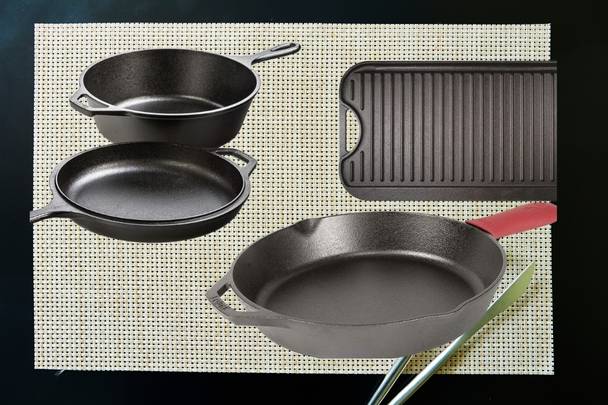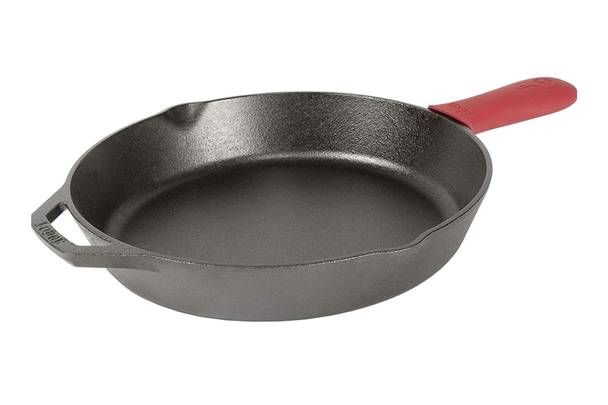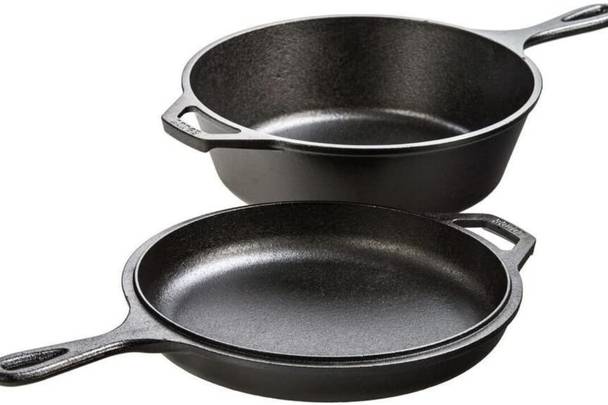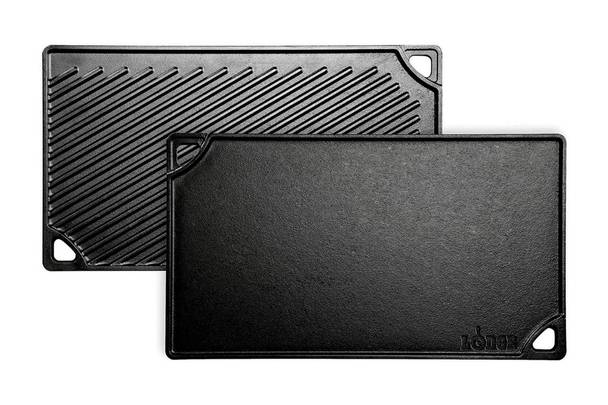Best Cast Iron Cookware

Cast iron is the one type of cookware that can perform almost anything in a kitchen. Cast iron pans, made of an ultra-durable steel and carbon alloy, heat and cook evenly and can withstand nicks, dents, and scratches that other types of pans are prone to.
You’ll need a nonstick pan for specific cooking but you should be able to use cast iron for most of your cooking and you don’t have to worry about scratching the pan like a nonstick pan.
It is versatile and going to last for a long time. Once the cast iron pan is seasoned well it is almost like a nonstick pan. Cast iron can be used to retain a steady temperature for deep frying, searing a steak, and even as bakeware.
There are numerous brands, models, and sizes to choose from. Here are few that you can check it out.
Lodge 12-inch cast iron pan

This 12-inch Lodge Cast Iron Skillet with Red Silicone Hot Handle Holder is made of thicker cast iron, slow to heat but will maintain its temperature well—perfect for getting a nice sear on steaks and anything else that needs browning. It comes pre-seasoned and very easy to clean.
It also came with a silicone handle cover that made removing it from the oven and placing it on the burner a simple. Overall, it’s a great pan at a good price.
10.25-inch Lodge Combo Cooker Cast Iron

This Made in America Lodge Combo Cooker Cast Iron comes as pre-seasoned when you buy and ready to use. It can be used on all cooking surfaces, oven, campfires and grills. You can make almost anything in these pans, bake, fry, stir fry, sear etc. The lid can also be used as pan.
Lodge Pre-Seasoned Cast Iron Reversible Grill/Griddle

This Cast Iron Reversible Grill is seasoned and ready to use for a natural, easy-release finish. Pancakes, Grilled cheese sandwiches, and eggs can all be made on the smooth side. Grilling foods like steak, fish, poultry, and hamburgers is a simple with the ribbed side.
How To Care for Your Cast Iron Cookware
Follow the instructions that came with your cookware as much as possible. Here are some general guidelines for care for your cast iron cookware.
- Most of these pans are now pre-seasoned when you buy them, but it’s still a good idea to clean them before using them. After washing, properly dry it, then apply a thin layer of oil to it and use a paper towel to wipe the surface until no oil residue remains. After that, it’s all set to go!
- After each use, wash your cast iron skillet by hand. You can use a small amount of soap. If needed, simply scrub it with warm/hot water with a pan scraper or brush. Then dry it by wiping it down with a lint-free cloth or paper towel. You can also place it on the stovetop on low heat for a few minutes to remove any excess moisture and prevent rust from forming. To keep it seasoned, simply wipe another thin layer of oil all over the surface of the pan using a paper towel or napkin.
- Do not soak your pan in water for an extended period of time. This will result in corrosion. If you wish to get rid of stubborn, stuck-on food, pour in some warm water and simmer for 3-5 minutes on the stove and things will start to soften and come up. Then use the scraper after the pan has cooled.
- Don’t be concerned if rust appears. Simply scrape the rust away with warm water. Then rinse, oil, and reheat it once more.
- Do not add cold water into a heated cast iron as this can cause warping or cracking. Cast iron is a brittle metal.
How To Cook on Cast Iron Cookware
- Preheat your skillet: To achieve consistent heating, pre-heat the cast iron skillet gradually. Because cast iron retains heat, a higher heat setting is not required. These steps help to prevent food from sticking. Remember to use a hot handle mitt!
- Once your pan is preheated, add a small amount of oil or fat. Then just add your food. If using butter, start with little oil and then add butter shortly before adding your food.
What does Cast Iron Seasoning Mean?
The oil baked onto the cast iron pan is referred to as seasoning. It’s what gives your skillet its unique black finish. Seasoning creates a natural, easy-release cooking surface and prevents rusting in your pan. Cast iron pans that have been well-seasoned can last for generations.
When you cook using oil, you’re potentially adding another layer of spice to the dish. Cooking acidic foods, using high temperatures, or scrubbing with abrasive tools or scouring pads can all remove a little seasoning. That’s why, as part of our simple cleaning instructions, you should rub oil into your pan after each use to keep the seasoning for great cooking.
How to Restore and Season a Rusty Cast Iron In the Oven
It’s simple! You can restore your cookware to like-new condition, whether you inherited rusted old cast iron or forgot to dry your skillet after washing it.
Most cast iron cookware is made with a combination of iron, steel, and alloys. Cast iron is prone to rust in the absence of a protective layer of carbonized oil known as seasoning. Even well-seasoned pans can rust if they are left in the sink to soak, placed in the dishwasher, allowed to air dry, or stored in a wet environment. There’s no reason to throw away a rusted cast iron skillet. Follow these simple steps to restore your cast iron finish and you’ll be able to cook for decades.
- Clean Your Pan: Using steel wool or a pan scraper, scrub the rusted areas. The pan should then be washed with warm, soapy water. This procedure may remove some of the seasoning, which is fine because we’re about to re-season the pan.
- Dry the Pan: Dry your cast iron skillet completely with a paper towel or lint-free cloth. To ensure that it is totally dry, you can also place it on the stovetop on low heat for a few minutes.
- Apply Thin Layer Oil: Using a cloth or lint-free paper towel, apply a very thin layer of cooking oil (vegetable oil, melted shortening, or canola oil) to the whole surface of your cast iron. Apply only a tiny layer of oil, not enough to drop or flow when you tilt it. Thin layers are required to bake seasoning into the pan.
- Bake for 1 hour: Preheat oven to 450–500 degrees Fahrenheit. To catch any excess oil, place aluminum foil on the bottom rack of the oven. Place your cookware on the center rack, upside down. This keeps oil from accumulating on the frying surface. 1 hour in the oven
- Cool In the Oven: Turn off the heat and place the cast iron skillet in the oven to cool. This causes the seasoning to form and stick to the iron more thoroughly.
Frequently Asked Questions
What oils are great for cooking in cast iron?
When cooking in cast iron, add a small amount of oil to the pan before adding your food. This keeps the food from sticking and helps to form seasoning layers. You can use whichever oil you like as long as the cooking temperature is below the oil’s smoke point.
Vegetable, Olive, sunflower, and grapeseed oils are all excellent multifunctional cooking oils that may be used for everything from sautéing to baking.
What oils are great for seasoning cast iron?
All cooking oils and fats can be used to season cast iron, although the cast Iron manufactures generally recommends vegetable oil, melted shortening, or canola oil due to availability, efficacy, cost, and having a high smoke point.
Whatever oil you pick, ensure sure your pan is heated to the smoke point of that oil. When the oil reaches the smoke point, a chemical reaction known as polymerization happens, attaching the oil to the pan and forming a coating of natural seasoning.
Why the cast Iron is sticky and gummy?
This can happen if you use too much oil to season your cast iron or if you don’t heat it long enough. It’s simple to fix! Return back it to the oven for another hour, or until the stickiness is gone.
Why my cast Iron looks dull and burnt, how to fix it?
If cast iron is heated without any oil on the cooking surface or with insufficient oil in the pan to cook the food, it will turn dull. The dullness occurs when the oil in the pan burns away before cooking. Simply re-season the pan to fix this. If your cast iron remains dull after re-seasoning, repeat the process until it has a small gloss.
Do Acidic foods in cast Iron remove the seasoning?
Unfortunately, it is possible. Foods that are highly acidic, such as tomatoes, can erode the seasoning on cast iron. Until the seasoning is completely set, we recommend avoiding acidic foods or dishes with higher liquid content for extended periods of time.
